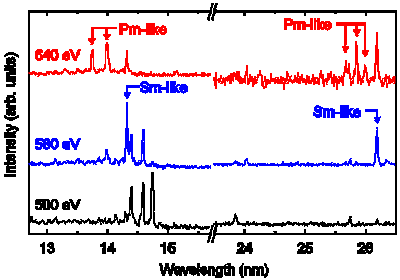Heavy ions and lost resonance lines

Identifying the ns-np resonance lines in alkali-metal-like ions is an important issue in fusion plasma science in the view of spectroscopic diagnostics and radiation power loss. Whereas for n = 2, 3 and 4 these resonances are prominent and well studied, so far no one could clearly identify the resonance lines for n = 5, the so-called promethiumlike sequence.
Nobuyuki Nakamura at the Institute of Laser Science of the University of Electro-Communications in Tokyo, and colleagues at the National Institute for Fusion Science and SOKENDAI have now experimentally clarified the reason for the lost resonance lines.
Nakamura and colleagues studied highly-charged bismuth ions using the electron-beam ion trap at The University of Electro-Communications in Tokyo. A compressed high-density electron beam ionizes the bismuth atoms that are then trapped by a combination of applied electric fields and the attraction force exerted by the electrons. The trapped ions keep colliding with the beam which leads to further ionization and the creation of highly-charged states like promethiumlike bismuth missing 22 electrons, or samariumlike missing 21 electrons.
The spectra are recorded with a spectrometer and compared to numerical calculations. Nakamura and co-workers show that the 5s-5p resonance lines are very weak in plasma with various electron densities, contrary to the theoretical prediction made more than thirty years ago, due to the presence of a long-lived metastable state.
More information: Yusuke Kobayashi,et al. "Spectroscopic study of promethiumlike bismuth with an electron-beam ion trap: Search for alkali-metal-like resonance lines." Phys. Rev. A 89, 010501(R), (2014).
Provided by University of Electro Communications



















